Quote:
Originally Posted by christofoo

...
There is also the caster shown; I still haven't decided for sure, but I think this is the way to go. This design means in a ground-strike the caster and hitch receiver will have to bear the weight of some of the vehicle. The caster here is rated at 300lbs, so it may or may not break. My experience is that the car will not strike at this departure angle if it's unloaded. So if I do this right, the weight on the caster should be no more than the load in the car, not the car itself. I've also set the bottom slope at 15.5° to keep the departure angle sane, which is faster than ideal but will still provide some aero benefit.
Another approach is to use a caster, hinge and chain so that the box can just bend out of the way instead of trying to support the vehicle. This would also enable lowering the bottom slope closer to the aerodynamic ideal. But space is tight between the trunk and the box, and it adds complexity, and I'm debating whether it's worth it, since I'd have to redesign everything. (Better now than later though.)
...
|
I overheard myself thinking aloud in that post and started to question my logic. So I started overhauling my CAD around Tue. LCD failure on my antiquated desktop caused some delay since my laptop is too new to run my CAD, but anyways I think the fixed bottom rail is probably not the way to go after all. At least not for a low ground-clearance vehicle like the Civic.
For one thing, the caster costs 2° of departure angle, resulting in 13.5° instead of 15.5°. For another, I want to avoid lifting the car using the hitch receiver. Class 1 should only have 200lbs tongue weight. Actually my Civic isn't rated for any towing at all, but I guess that just means I need to upgrade the rear shocks and stick to Class 1, for the purposes of a hitch box. (Anyways it hasn't stopped me so far.)
The orange triangle depicts a 26° wedge between the box and the hood if I locate the hinge at the point of the triangle. This pic also gives you an idea as to how I'm defining the envelope for the hitch box; I put all the pixel coordinates of the red dots into a spreadsheet and defined the scale using the known dimension specs (3.8pix/inch).
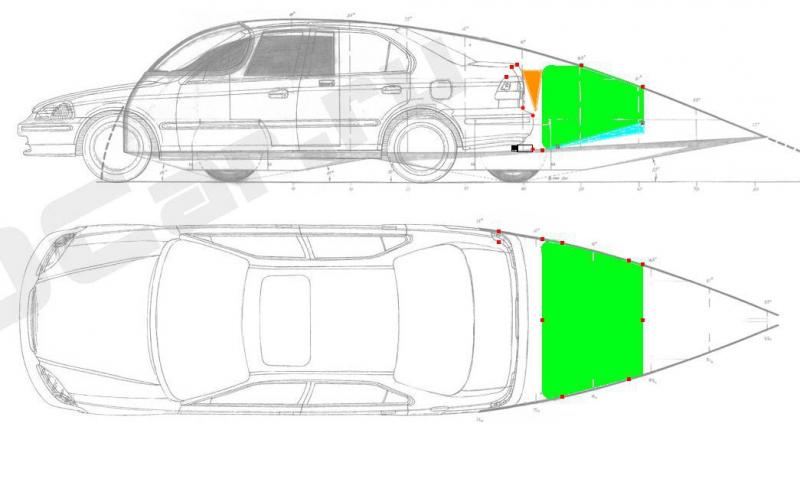
Now for a demonstration: in this picture there is an 'invisible' car between the hitch box and the rear tires (actually just dimensional constraints that hold them together in the right place). The ramp is at 15.5° and the driver didn't turn into it. I believe my own driveway is around 15-15.5° and it's one of the worst I ever use.
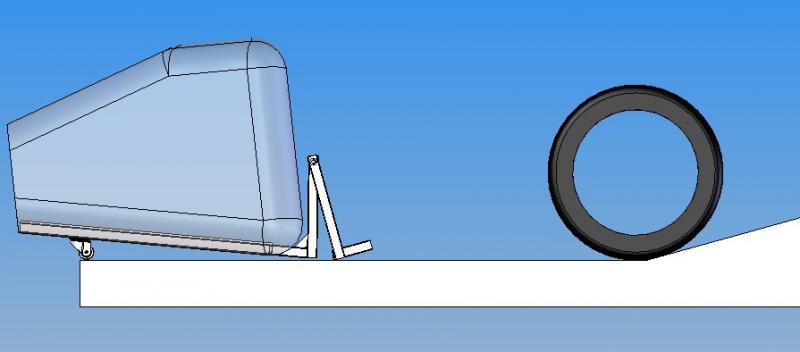
The same, but now the ramp is at 16.5° since the driver angled the car to 10°. You can see the front corners of the box are under threat and there's nothing the caster can do about it. I can shorten one of the posts so the box is higher in the front. I have already taken off 0.5" and that made a big difference. But the more I do this, the more it (maybe) becomes less aerodynamic with flow detachment on the bottom. EDIT: I think this is actually not as bad as it looks since the suspension will tend to compensate.
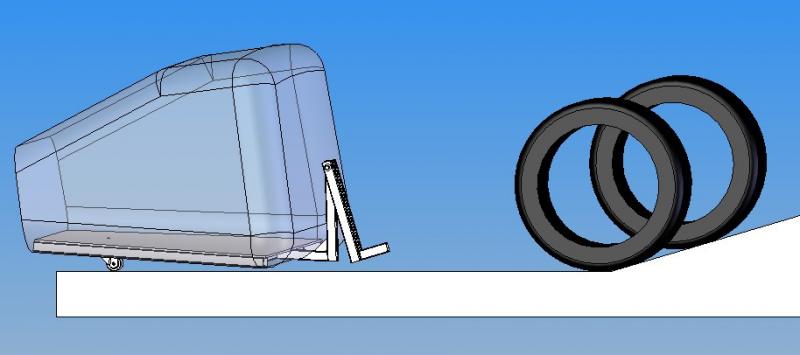
Now the driver turns to 20°. No problem here. If the driver turns in much steeper the box just stays off the ground and never even hinges. EDIT: this speaks to COcyclist's concern. In most situations the center caster is adequate, at least for the hinged version.
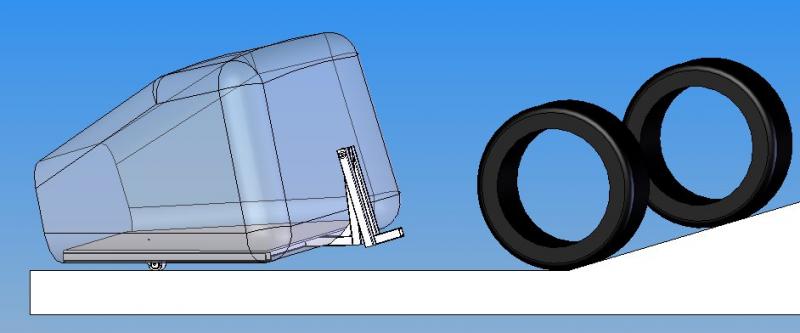
However, sidewalks can strike the front of the box if the ramp angle is over about 15°, and if the driver backs in or faces out.
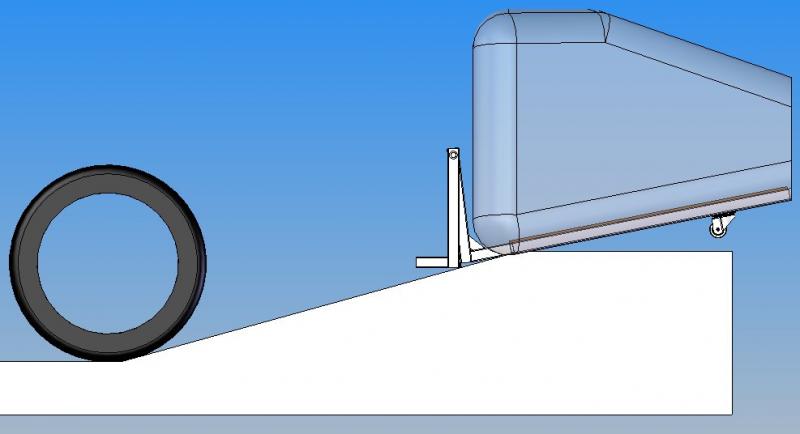
The driver should avoid doing this on steep driveways that have sidewalks. This probably deserves a little more thought because it can be a big deal in business parking lots, i.e. where facing out is required.
And so, here is my v2 implementation:
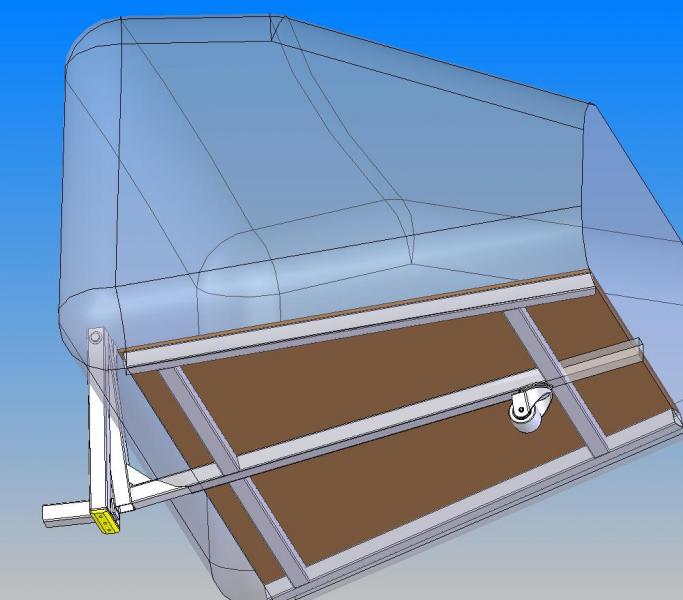
- Hinged frame located right behind the rear bumper. The trunk is just above this and can still open with the hitch box in place.
- Using a clevis pin in the 'hinge', so the hitch box can be installed and removed in two pieces. Expecting to use this feature a lot since I want to keep heavy stuff in the trunk. Hard to get heavy stuff in and out of the trunk with a hitch box in the way, even if the trunk opens. Hmm, I should probably change over to a locking pin so my box doesn't get stolen.
- The location of the hinge also deserved some thought; if the pivot point is too low then braking can cause the box to swing forward, depending on how it's loaded. Also if it is too high at some point it impinges on the trunk. For the 16.5° ramp the box only hinged about 11°, so I still have plenty of space there.
- 1.25" steel square tube frame, welded. 120-wall for the two bottom-center rails, 60-wall for everything else.
- The yellow pad at the bottom is machined from UHMW polyethylene. I'm hoping this material is tough enough and slick enough to act a bit like a caster in case this area strikes. The advantage over a caster is that it is much lower profile. I was hoping to avoid machined parts, but at least this is light duty, and if I decide against it I might just do a sacrificial 1/8" steel plate here with beveled edges.
- I believe in controlling failure. I might also attach strips of UHMW PE under each of the three front-to-back floor frames. That might be the partial solution if there is a genuine issue facing out of business parking lots with sidewalks.
Man, what a load of details. For anyone who wants my CAD for whatever, I put it here:
Index of /files
Tomorrow I got to get the shop cleaned up and ready to use the new welder and planishing hammer.
